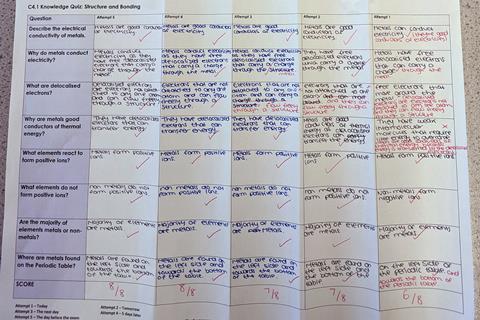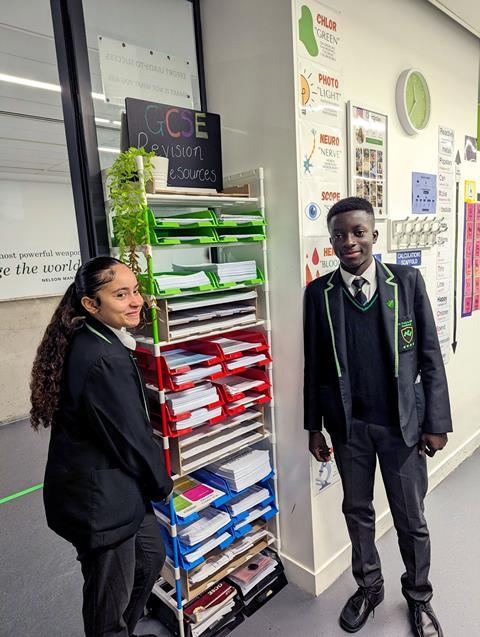Revision shouldn’t start just before exams, so spring into action with these techniques from the get-go

I’ve often found students don’t understand what effective revision looks like. They highlight facts and read the text over and over in the hope they will absorb the information. But not only is this too simplistic and not effective, it doesn’t transfer the knowledge to the students’ long-term memories.
I use low-stakes retrieval practice to help my students retain information. Here are four approaches I’ve used successfully.

1. Progress with test-and-fold retrieval quizzes
Test-and-fold retrieval quizzes
I’ve had great results with this method. This method works best on an A3 piece of paper so the students have lots of room to write their answers. I list eight to 20 questions in the first column, then the other columns are for the students to add their answers each time they attempt the questions. We often complete the first attempt together in class, so everyone knows the answers. Learners then fold that column back so when they revisit the questions for attempt two, they can’t see the answers. They attempt the quiz again in their own time at agreed intervals – one day, three days, one week and two weeks – and write their answers in the attempt columns. After each attempt, they write their scores in the bottom row so they can see their progress.
This has worked really well for my students, building their knowledge retention and helping secure understanding in their long-term memory. They say they find it fun to do and enjoy being able to measure their progress.
2. Rehearse with flash cards
Flash cards
I find these great for revision. It’s a simple yet effective concept, and works well if students start early in the school year. On the front of the card, they write a key term or question and, on the back, the answer or definition, using both pictures and text.
My students often test each other with them during lunch breaks and again, this has led to great results as well as positive feedback. They say that when they rehearse the answers out loud, it helps them remember the details. Their aim is to try to answer all their flash cards correctly at least three times. I get them to organise the cards onto three pieces of coloured paper: red – I don’t know; amber – I need bit more work; and green – I’m confident. This is so useful when they need to prioritise their time before and during exams.

3. Use past papers for independent practice
Past papers
Past papers can be a useful revision tool; they help learners understand where they are in terms of content, embedded knowledge and their ability to apply that knowledge. And when learners do them in their own time, the stakes are lower than in the classroom under exam conditions.
To ensure my students always have access to past papers I’ve set up a revision resources shelf by the classroom door so they can help themselves. This has worked really well; they have easy access to exactly what they need and the shelf helps them take ownership of their revision. I refill the papers regularly to ensure everyone can reattempt the same exam questions in the future and try new ones. Once they’ve completed (or tried hard to complete) a paper I give them the mark scheme with instructions to read it carefully and add in a different colour what they missed, or didn’t word correctly.
4. Find peculiar mnemonics
Mnemonics
I use mnemonics when possible because my students find them useful and interesting. The more peculiar the mnemonic, the more likely they are to remember and use it to guide them. When I’m marking their exams I love to see a mnemonic written down the side of their paper.
I use mnemonics when possible because my students find them useful and interesting. The more peculiar the mnemonic, the more likely they are to remember and use it to guide them (rsc.li/4bJ2fQ7). When I’m marking their exams I love to see a mnemonic written down the side of their paper.
For example, I teach VESRAU for completing calculations and to show working out.
Values – highlight any numbers and their units and write them out in the values section. Convert units if necessary.
Equation – write out the version of the equation you know or have been given (e.g., rate = mass ÷ time).
Substitute – put your values into the equation.
Rearrange – if you need to, rearrange your equation and substitute the values in again.
Answer – use your calculator to calculate your answer. Double check it!
Units – write your final answer with the correct unit. Read the question again.
My aim with these techniques is to not just help students revise, but to revise effectively, and I hope these ideas will prove just as useful in your classroom.
Find more inspiration for effective strategies in our revision collection.
Kemi Anigiobi
Find more inspiration for effective strategies in our revision collection: rsc.li/3Lrbaen











No comments yet